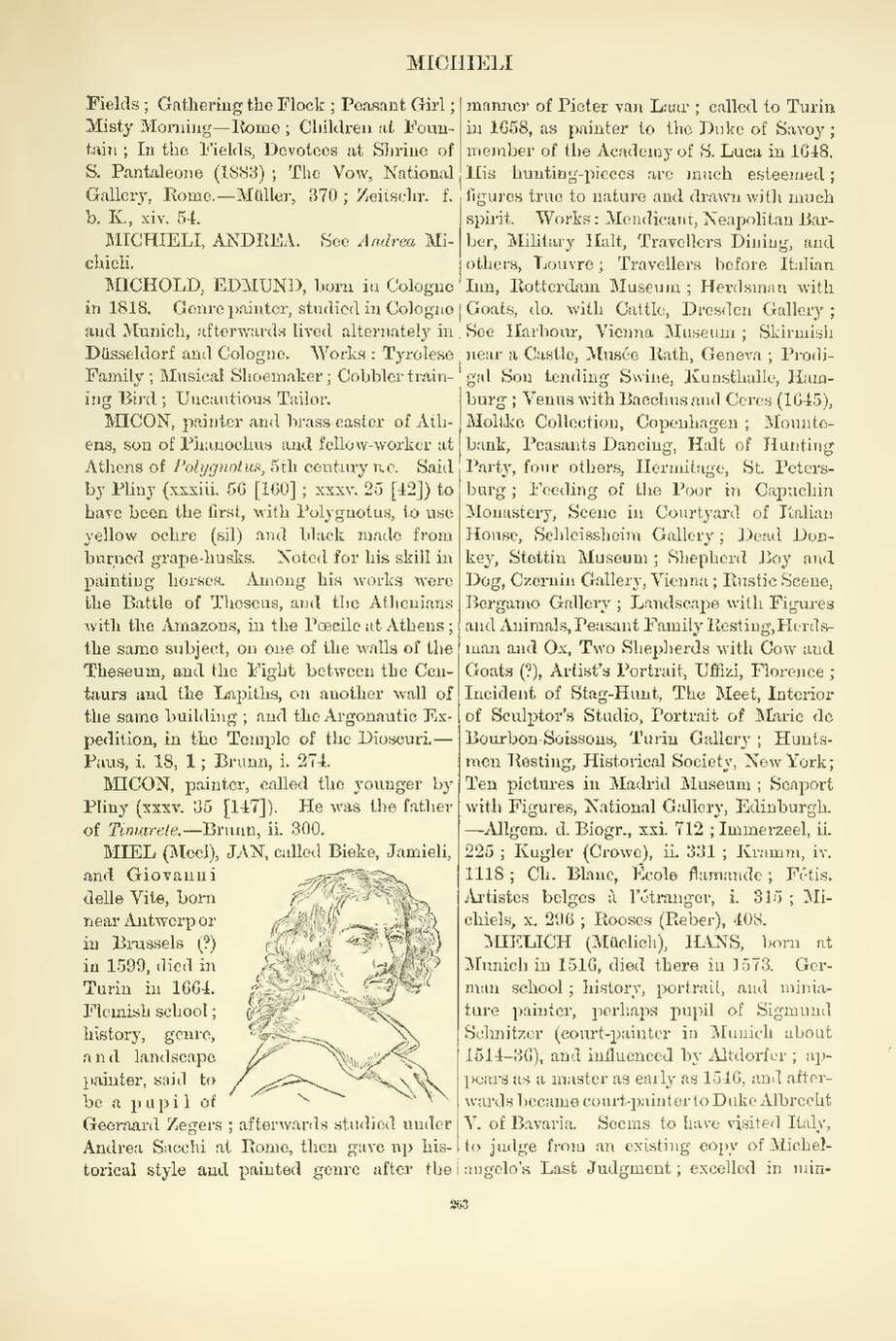Fields; Gathering the Flock; Peasant Girl; Misty Morning—Rome; Children at Fountain; In the Fields, Devotees at Shrine of S. Pantaleone (1883); The Vow, National Gallery, Rome.—Müller, 370; Zeitschr. f. b. K., xiv. 54.
MICHIELI, ANDREA. See Andrea Michieli.
MICHOLD, EDMUND, born in Cologne
in 1818. Genre painter, studied in Cologne
and Munich, afterwards lived alternately in
Düsseldorf and Cologne. Works: Tyrolese
Family; Musical Shoemaker; Cobbler training
Bird; Uncautious Tailor.
MICON, painter and brass caster of Athens,
son of Phanochus and fellow-worker at
Athens of Polygnotus, 5th century B.C. Said
by Pliny (xxxiii. 56 [160]; xxxv. 25 [42]) to
have been the first, with Polygnotus, to use
yellow ochre (sil) and black made from
burned grape-husks. Noted for his skill in
painting horses. Among his works were
the Battle of Theseus, and the Athenians
with the Amazons, in the Pœcile at Athens;
the same subject, on one of the walls of the
Theseum, and the Fight between the Centaurs
and the Lapiths, on another wall of
the same building; and the Argonautic Expedition,
in the Temple of the Dioscuri.—Paus,
i. 18, 1; Brunn, i. 274.
MICON, painter, called the younger by
Pliny (xxxv. 35 [147]). He was the father
of Timarete.—Brunn, ii. 300.
An image should appear at this position in the text. To use the entire page scan as a placeholder, edit this page and replace "{{missing image}}" with "{{raw image|Cyclopedia of painters and paintings (IA cyclopediaofpain03cham).pdf/285}}". Otherwise, if you are able to provide the image then please do so. For guidance, see Wikisource:Image guidelines and Help:Adding images. |
MIEL (Meel), JAN, called Bieke, Jamieli,
and Giovanni
delle Vite, born
near Antwerp or
in Brussels (?)
in 1599, died in
Turin in 1664.
Flemish school;
history, genre,
and landscape
painter, said to
be a pupil of
Geeraard Zegers; afterwards studied under
Andrea Sacchi at Rome, then gave up historical
style and painted genre after the
manner of Pieter van Laar; called to Turin
in 1658, as painter to the Duke of Savoy;
member of the Academy of S. Luca in 1648.
His hunting-pieces are much esteemed;
figures true to nature and drawn with much
spirit. Works: Mendicant, Neapolitan Barber,
Military Halt, Travellers Dining, and
others, Louvre; Travellers before Italian
Inn, Rotterdam Museum; Herdsman with
Goats, do. with Cattle, Dresden Gallery;
See Harbour, Vienna Museum; Skirmish
near a Castle, Musée Rath, Geneva; Prodigal
Son tending Swine, Kunsthalle, Hamburg;
Venus with Bacchus and Ceres (1645),
Moltke Collection, Copenhagen; Mountebank,
Peasants Dancing, Halt of Hunting
Party, four others, Hermitage, St. Petersburg;
Feeding of the Poor in Capuchin
Monastery, Scene in Courtyard of Italian
House, Schleissheim Gallery; Dead Donkey,
Stettin Museum; Shepherd Boy and
Dog, Czernin Gallery, Vienna; Rustic Scene,
Bergamo Gallery; Landscape with Figures
and Animals, Peasant Family Resting, Herdsman
and Ox, Two Shepherds with Cow and
Goats (?), Artist's Portrait, Uffizi, Florence;
Incident of Stag-Hunt, The Meet, Interior
of Sculptor's Studio, Portrait of Marie de
Bourbon-Soissons, Turin Gallery; Huntsmen
Resting, Historical Society, New York;
Ten pictures in Madrid Museum; Seaport
with Figures, National Gallery, Edinburgh.—Allgem.
d. Biogr., xxi. 712; Immerzeel, ii.
225; Kugler (Crowe), ii. 331; Kramm, iv.
1118; Ch. Blanc, École flamande; Fétis,
Artistes belges à l'étranger, i. 315; Michiels,
x. 296; Rooses (Reber), 408.
MIELICH (Müelich), HANS, born at
Munich in 1516, died there in 1573. German
school; history, portrait, and miniature
painter, perhaps pupil of Sigmund
Schnitzer (court-painter in Munich about
1514-36), and influenced by Altdorfer; appears
as a master as early as 1546, and afterwards
became court-painter to Duke Albrecht
V. of Bavaria. Seems to have visited Italy,
to judge from an existing copy of Michelangelo's
Last Judgment; excelled in min-
